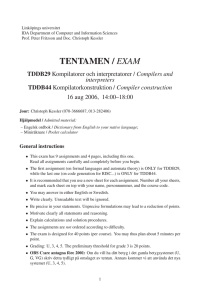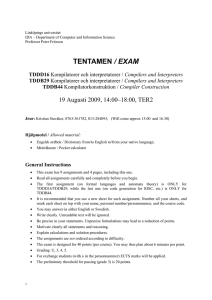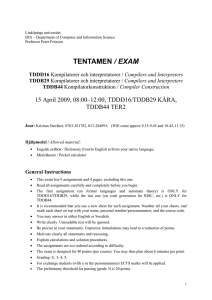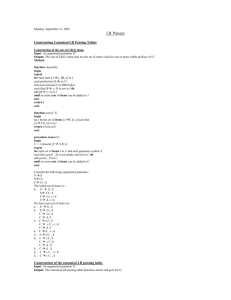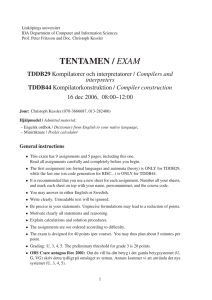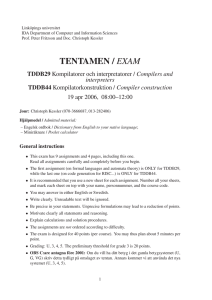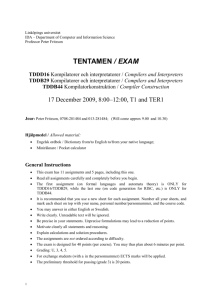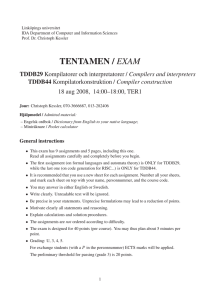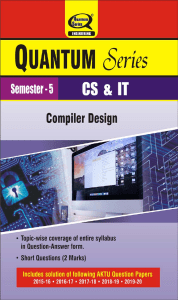Tentamen/Exam TDDB44 Kompilatorkonstruktion / Compiler Construction TDDD55 Kompilatorer och interpretatorer /
advertisement
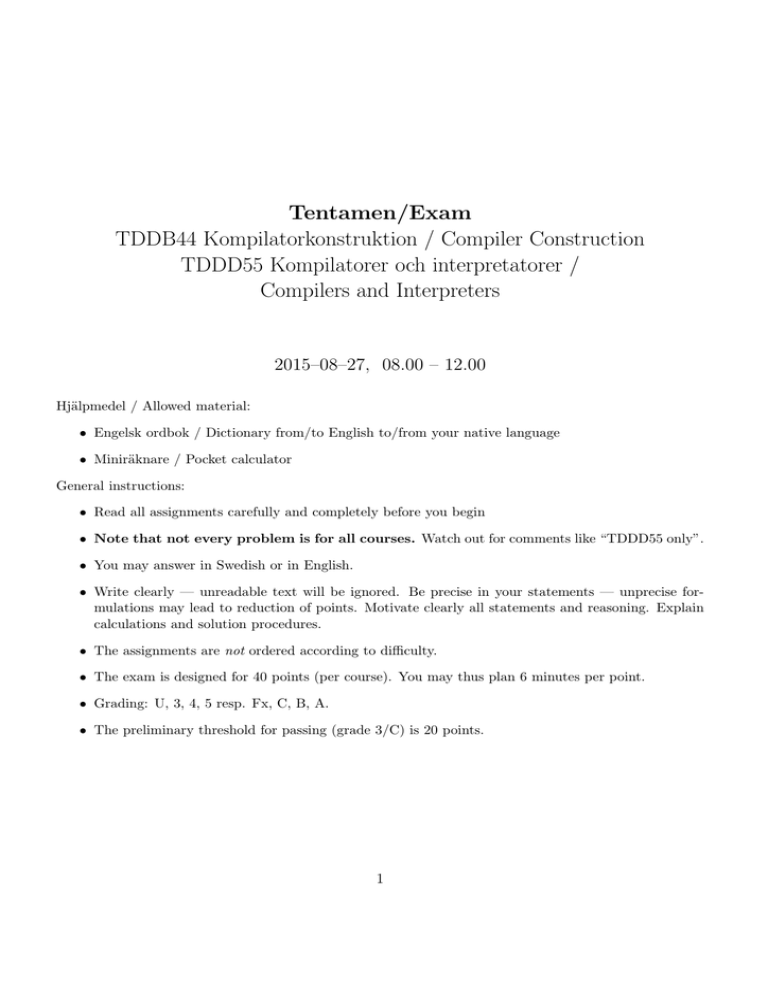
Tentamen/Exam
TDDB44 Kompilatorkonstruktion / Compiler Construction
TDDD55 Kompilatorer och interpretatorer /
Compilers and Interpreters
2015–08–27, 08.00 – 12.00
Hjälpmedel / Allowed material:
• Engelsk ordbok / Dictionary from/to English to/from your native language
• Miniräknare / Pocket calculator
General instructions:
• Read all assignments carefully and completely before you begin
• Note that not every problem is for all courses. Watch out for comments like “TDDD55 only”.
• You may answer in Swedish or in English.
• Write clearly — unreadable text will be ignored. Be precise in your statements — unprecise formulations may lead to reduction of points. Motivate clearly all statements and reasoning. Explain
calculations and solution procedures.
• The assignments are not ordered according to difficulty.
• The exam is designed for 40 points (per course). You may thus plan 6 minutes per point.
• Grading: U, 3, 4, 5 resp. Fx, C, B, A.
• The preliminary threshold for passing (grade 3/C) is 20 points.
1
1. (TDDD55 only - 6p) Formal Languages and Automata Theory
Consider the language L consisting of all strings w over the alphabet {0, 1} such that every
string contains 00 once and 11 once. Example of strings in the language: 1001011, 1100.
Examples of strings not in the language: 0101, 1011, 01011011, 000. (The last example
counts as two occurences of 00.)
(a) (2p) Construct a regular expression for L.
(b) (1.5p) Construct from the regular expression an NFA recognizing L.
(c) (2.5p) Construct a DFA recognizing L, either by deriving it from the NFA or by constructing it directly.
2. (4p) Compiler Structure and Generators
(a) (1p) What are the advantages and disadvantages of a multi-pass compiler (compared to
an one-pass compiler)?
(b) (3p) Describe briefly what phases are found in a compiler. What is their purpose, how
are they connected, what is their input and output?
3. (2p) Symbol Table Management
Describe what the compiler — using a symbol table implemented as a hash table with chaining
and block scoped control — does in compiling a statically scoped, block structured language
when it handles:
(a) (0.5p) block entry
(b) (0.5p) block exit
(c) (0.5p) a variable declaration
(d) (0.5p) a variable use.
2
4. (5p) Top-Down Parsing
(a) (4.5p) Given a grammar with nonterminals S, A, B and the following productions:
S ::= S u | P Q v | P Q w
P ::= P x | y
Q ::= Q z | e
where S is the start symbol, u, v, w, x, y, z are terminals. (e is the empty string!)
What is/are the problem(s) with this grammar if it is to be used for writing a recursive
descent parser with a single token lookahead? Resolve the problem(s), and write a
recursive descent parser for the modified grammar. (Pseudocode/program code without
declarations is fine. Use the function scan() to read the next input token, and the
function error() to report errors if needed.)
(b) (0.5p) The theory for formal languages and automata says that a stack is required for
being able to parse context-free languages. We have used such a stack, for instance, in
the LL-item pushdown automaton in the lecture on top-down parsing. But where is the
corresponding stack in a recursive descent parser?
5. (TDDD55 only - 6p) LR parsing
(a) (3p) Use the SLR(1) tables below to show how the string x+y*x-y is parsed. You should
show, step by step, how stack, input data etc. are changed during the parsing. Start
state is 00, start symbol is S.
Grammar:
1.
2.
3.
4.
5.
6.
7.
S ::= P * P
P ::= Q + P
| Q
Q ::= Q - R
| R
R ::= x
| y
3
Tables:
State
----00
01
02
03
04
05
06
07
08
09
10
11
12
Action
======
$
*
+
x
y
----------------------*
*
*
* S09 S10
A
*
*
*
*
*
* S03 *
*
*
*
*
*
*
* S09 S10
R1
*
*
*
*
*
R3 R3 S06 S11 *
*
*
*
*
* S09 S10
R2 R2
*
*
*
*
R5 R5 R5 R5
*
*
R6 R6 R6 R6
*
*
R7 R7 R7 R7
*
*
*
*
*
* S09 S10
R4 R4 R4 R4
*
*
Goto
====
S P Q R
-----------01 02 05 08
* * * *
* * * *
* 04 05 08
* * * *
* * * *
* 07 05 08
* * * *
* * * *
* * * *
* * * *
* * * 12
* * * *
(b) (3p) Explain the concept of conflict in LR parsing — what it is, how it could be handled.
6. (TDDB44 only - 6p) LR parsing
Given the following grammar G for strings over the alphabet {a,b,c,d} with nonterminals X
and Y, where X is the start symbol:
X ::= Xb | aX | aYb | c
Y ::= bY | Ya | bXa | d
Is the grammar G in SLR(1) or even LR(0)? Justify your answer using the LR item sets.
If it is: construct the characteristic LR-items NFA, the corresponding GOTO graph, the
ACTION table and the GOTO table and show with tables and stack how the string abcab
is parsed.
If it is not: describe where/how the problem occurs.
4
7. (5p) Syntax-Directed Translation
A Pascal-like language is extended with a restartblock statement according to the following
grammar:
<block>
::= begin <stmt_list> end
<stmt_list> ::= <stmt_list><stmt> |
<stmt>
::= <assignment> | ... | restartblock
(where “...” represents all other possible kinds of statements). restartblock means that
execution restarts at the beginning of the immediately enclosing block.
Example:
begin
x:=17;
L1: begin
y:=y-42;
if p=4711
L2:
then restartblock;
else q:=q-1;
L3: end;
end;
where restartblock at L2 means a jump to L1 (i.e. the beginning of the enclosing block).
(a) (4p) Write a syntax-directed translation scheme, with attributes and semantic rules, for
translating <block>s, and restartblocks inside them, to quadruples. The translation
scheme should be used during bottom-up parsing. You are not allowed to define and
use symbolic labels, i.e. all jumps should have absolute quadruple addresses as their
destinations. You may need to rewrite the grammar. Explain all the attributes, functions, and instructions that you introduce. State all your assumptions. (Since it is a
syntax-directed translation scheme, not an attribute grammar, generation of a quadruple
puts it in an array of quadruples and attribute values are ”small” values such as single
quadruple addresses.)
(b) (1p) What problem would occur in handling of the translation scheme if instead of
restartblock there would be an exitblock statement that jumped to the end of the
immidiately enclosing block (instead of the begin), i.e. to L3 in this example?
5
8. (3p) Error Handling
Explain, define, and give examples of using the following concepts regarding error handling:
(a) (1p) Valid prefix property,
(b) (1p) Phrase level recovery,
(c) (1p) Global correction.
9. (3p) Memory management
(a) (1p) Non-local references: How does a static link work?
(b) (1p) Non-local references: How does a display work?
(c) (1p) Dynamic data: How is the actual size and contents of a dynamic array han dled?
10. (6p) Intermediate Code Generation
(a) (3p) Given the following code segment in a Pascal-like language:
if 12321<fac(x-1)
then repeat
y=fac(x);
x=x+y;
until x>50000
else z=2
Translate the code segment into an abtract syntax tree, quadruples, and postfix code.
(b) (3p) Divide the following code inte basic blocks, draw a control flow graph, and show
as well as motivate the existing loop(s).
L1:
L2:
L3:
L4:
L5:
goto L2
x:=x+1
x:=x+1
x:=x+1
if x=1 then goto L1
if x=2 then goto L4
goto L5
x:=x+1
x:=x+1
if x=4 then goto L1
6
11. (TDDB44 only - 6p) Code Generation for RISC etc.
(a) (2p) Explain the main characteristics of CISC and RISC architectures, and their differences.
(b) (1.5p) Explain the main similarity and the main difference between superscalar and
VLIW architectures from a compiler’s point of view. Which one is harder to generate
code for, and why?
(c) (1.5p) Explain briefly the concept of software pipelining. Show it with a simple example.
(d) (1p) What is a live range? Explain the concept and show a simple example.
7

